Windows 10's summer launch date is first step in a slow roll-out

At a private event for press and analysts on Thursday, Microsoft revealed more details about its Windows 10 launch plans.

Joe Belfiore, Corporate Vice President of Microsoft's Operating Systems Group, confirmed what most Microsoft watchers had previously suspected: The summer launch will be only for the client version of Windows 10, on x86-based PCs and tablets. The Windows 10 releases for phones, small tablets, Xbox, and Hololens will follow at unspecified later dates, probably this year.
In earlier Windows development cycles, this summer's launch event would have been labeled Release to Manufacturing, or RTM. In the new Microsoft, that phrase is outdated. Instead, what happens at launch is that the final, ready-for-the-general-public build of Windows 10 will be declared the Current Branch. At that point it will be available via update, for free, to any existing devices running Windows 7 Service Pack 1 or Windows 8.1.
Belfiore also confirmed that the Windows Insider program will continue after the launch event. Registered members of the Insider program who've been testing preview releases will be offered the option to switch to the Current Branch or remain in the preview program.
Those who choose to remain on what Microsoft is calling the "active branch" will continue to get new updates ahead of the public, with those updates making their way to the Current Branch when they're deemed stable enough for release.
Featured
This summer's launch is just the first step in an endless rolling Windows release cycle.
Some features that have been demonstrated publicly will not be available in the initial launch version. The promised support for extensions in the new Microsoft Edge browser (previously code-named Project Spartan) will come later, for example, as will support for packaged Windows desktop apps delivered through the Windows Store.
As ZDNet's Mary-Jo Foley has previously reported, Microsoft plans a major feature update for Windows 10, code-named Redstone, in 2016. That's just the first of several major updates to Windows 10 coming in the next few years.
Some enterprise features are also likely to lag the initial launch, coming before or in sync with the launch of Windows Server 2016 next year.
Microsoft didn't offer any definitive word on when new PCs and tablets with Windows 10 will appear, but one exec told me to expect a much shorter window than in previous Windows releases. In both the Windows 7 and Windows 8 cycles, for example, the RTM date was in July, but PCs weren't available for sale until October. This time, the window before OEM devices are available could be weeks.